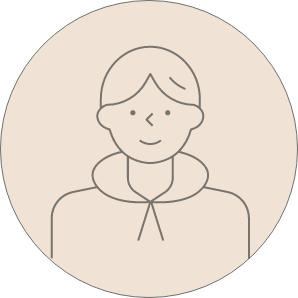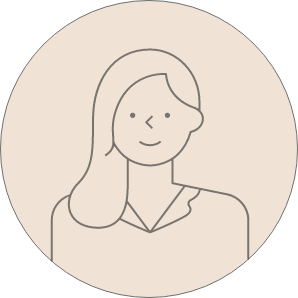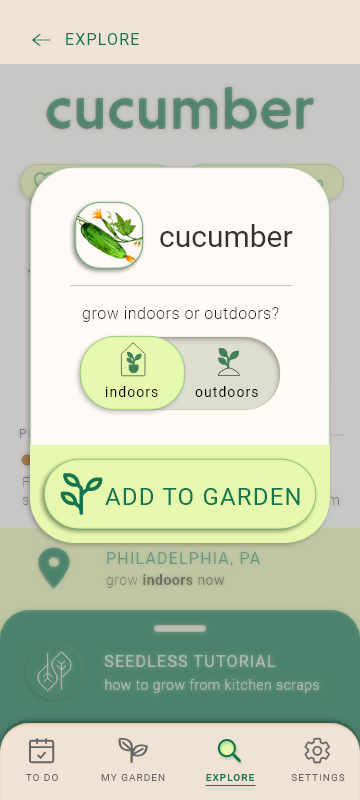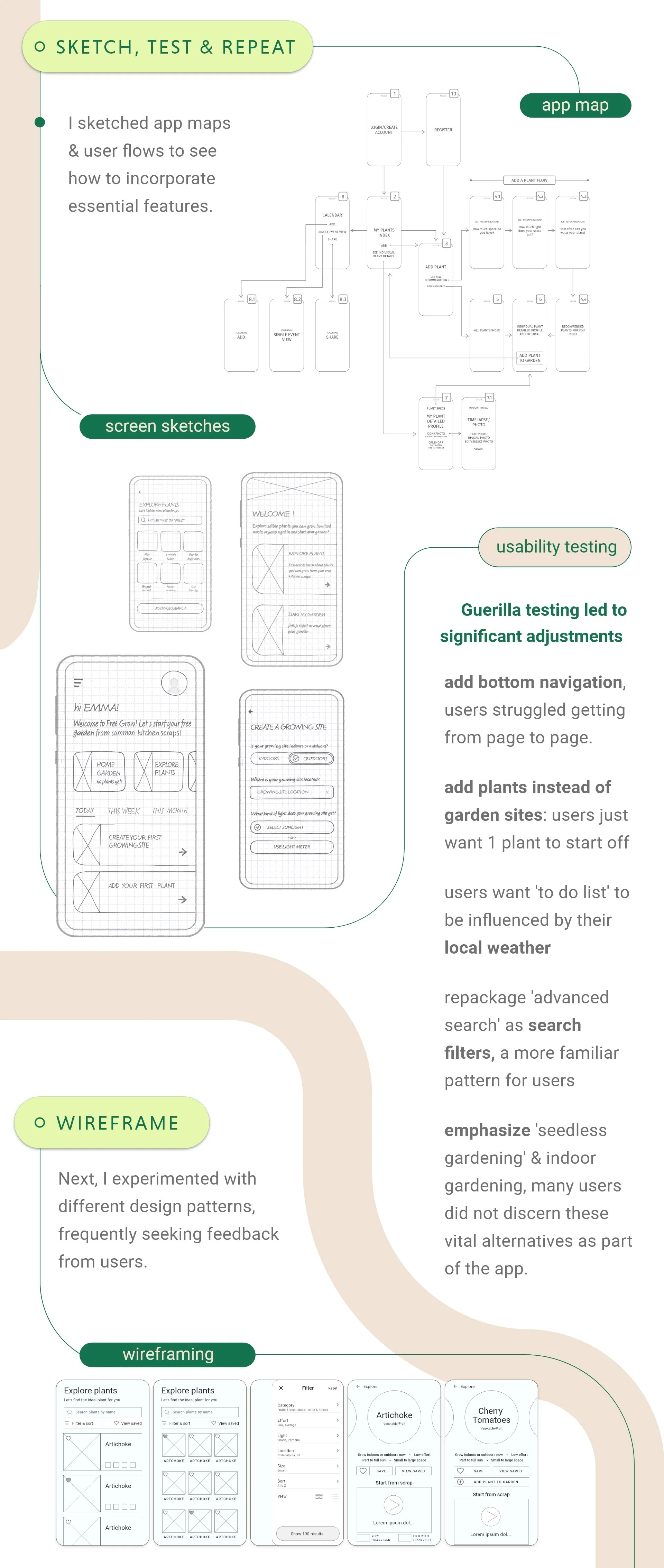App UX Design
Product: Gardening companion mobile app Duration: October - November 2021
As part of my Springboard UX Design course I created a mobile app for new gardeners.
Case Study Text
design process
1. Discover & Define
The Problem: More people than ever before are interested in growing their own food, but many more would-be gardeners are deterred by the difficulty of getting started.
2. Ideate & Prototype
The Solution: Seedless encourages & guides new gardeners through starting and maintaining edible plants in the simplest way possible—'re-growing' left over grocery store produce.
3. Test & Validate
The Result: 100% of users felt significantly more confident about starting an edible garden. 60% of users grew edible plants for the very first time.
1. discover & define
Methods: Interviews & Surveys, Secondary & Competitive Research
Understanding target users
I conducted research to understand & empathize with the target user, & gained key insights such as:
Persona
25-34 year-old millennials are the heaviest mobile app users.
Most millennials rent in urban areas; lack of outdoor space makes edible gardening seem like a non-starter.
80% of millennials are interested in growing their own food, but only 30% do so.
See full Persona created based on target users click to enlarge
Understanding Pain points
Would-be gardeners are overwhelmed by the tasks & variables associated with getting started, especially:
A major barrier for would-be gardeners? Seeds.
Waiting for the correct time to start each plant
Figuring out which plants work for your circumstances
Choosing the right strain of seeds, where to buy them, and how to plant them
Learning when to water plants & sticking to a schedule
deliverables
Affinity map synthesizing user interview notes
Empathy map
Research Presentation
2. ideate & prototype
Constraints: Create a mobile app related to home gardening; 2 month time frame
problem question
Based on the research, I created the main problem question for my product: “how might we make starting edible plants more accessible to new gardeners?”
user stories
I identified the 2 most essential user stories:
“As a novice gardener, I want suggestions on the best plants to grow right now and help remembering what I need to do to maintain them."
“As someone who is intimidated by starting a garden, I want guidance on the simplest way to get started; ideally it could be a brief activity I can do on a whim, without planning or shopping.”
heuristic analysis of competitor apps
I chose three of Jakob Nielsen’s ten heuristic principles to assess potential competitors in the home gardening companion space.
Envision
Next, I envisioned each of the features the app would need to include.
Account creation & settings
Searchable catalog of edible plants
Personal garden
Seedless gardening tutorials: how to 're-grow' each plant from grocery store produce
Tasks Calendar: generate schedule for plants in user's personal garden
Sketch, Test & repeat
User Flow
App map
Screen sketches
I sketched app maps, user flows, and screens to see how to incorporate essential features.
Guerilla usability testing led to significant adjustments:
add bottom navigation, users struggled getting from page to page
add plants instead of garden sites: users just want 1 plant to start off
users want 'to do list' to be influenced by their local weather
repackage 'advanced search' as search filters, a more familiar pattern for users
emphasize 'seedless gardening' & indoor gardening, many users did not discern these vital alternatives as part of the app.
wireframe
Next, I experimented with different design patterns, frequently seeking feedback from users.
Initial wireframes
Wireflow
Logo & Visual Design
Once I had determined the architecture of the app, I dove into branding and user interface design.
The name ‘Seedless’ communicates the simplicity of gardening without seeds—no prior experience is needed. The two interlocking leaves in the logo suggest continuity, recalling the widely recognized symbol for recycling, and forming an 'S' for Seedless.
The logo was the primary inspiration for the visual design of the app. I wanted the app to look clean, bright & friendly, in contrast to the gardening process which can be dirty and often frustrating. I ensured all color pairings were fully accessible.
Prototype
After working out the screens & content organization in wireframes, I applied my visual design system to create a hi-fidelity, interactive prototype of all main screens:
Explore: Catalog of all edible plants with thumbnail image for each. Search & filter by particular criteria including user's geographical location. Save favorite plants.
Explore Plant Details: Image & breakdown of essential info for each plant, including compatibility with user's geographical location & link to seedless tutorial. Add plants to user's garden via pop-up dialog.
My Garden: Catalog of user's plants. Click thumbnails to view user's plant's details pages with each plants status & essential info.
My Garden Plant Details: Image, plant location, status & breakdown of essential info for each plant & link to seedless tutorial. Edit plant info and notifications.
Seedless Tutorial: Illustrated tutorial & video tutorial for each plant on how to 'regrow' from grocery store produce rather than from seeds.
To Do: App generated to-do list for user's plants incorporating local weather. Mark tasks completed & see task history.
3. test & validate
usability testing
I ran 2 rounds of moderated usability tests, each with 6 participants, for a total of 12 unique participants. Each test lasted 30 minutes. Participants were asked to complete 8 tasks. The prototype was used on a mobile device in a home setting to help with contextual observations.
After the 1st round of testing, I further refined my prototype. In the 2nd round of user testing, 100% of users completed all tasks.
I surveyed 5 of my test users 2 weeks after their experience with my prototype to evaluate the app's impact:
100% of users reported feeling significantly more confident about starting an edible garden.
60% started growing edible plants for the first time.
lessons learned
Test concepts. Be flexible to change your initial hypothesis
Test early and often. It will guide you to the best solution.
Zoom out, zoom in. Think wide, consider the end to end experience.
Quick sketches are invaluable to prevent wasting time.
Build what will fill an unmet need, not what you want.
I was excited to build on my skills and previous experience as a product designer by learning about design thinking and research strategies. I hope you’ve enjoyed this case study.
Email me at callimryan@gmail.com or message me on linkedin.com/in/calliryan if you'd like to know more.






























































